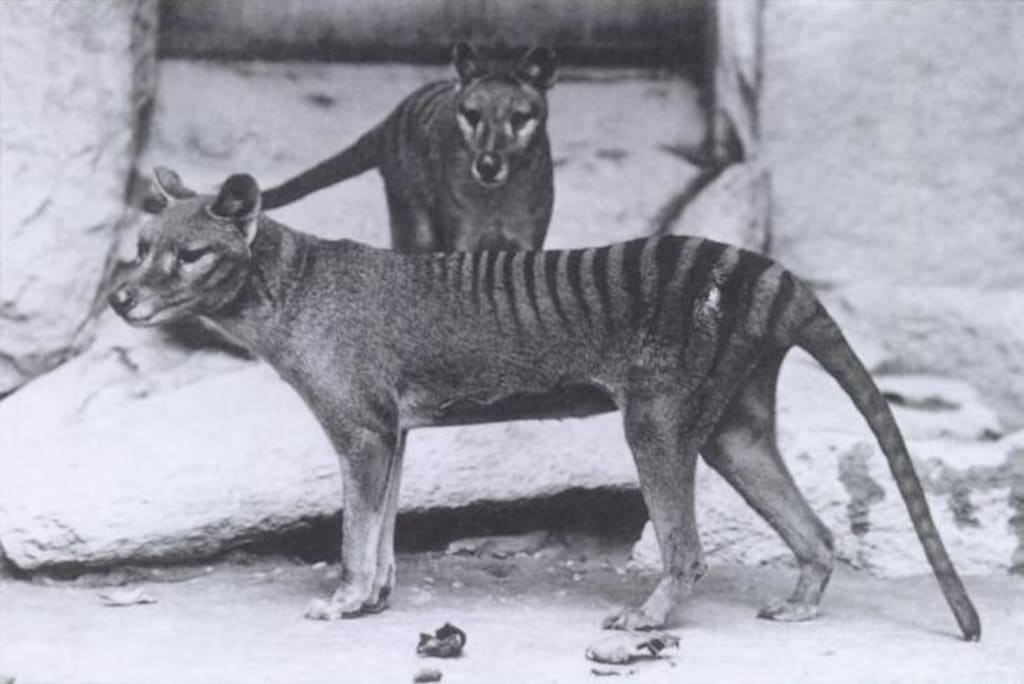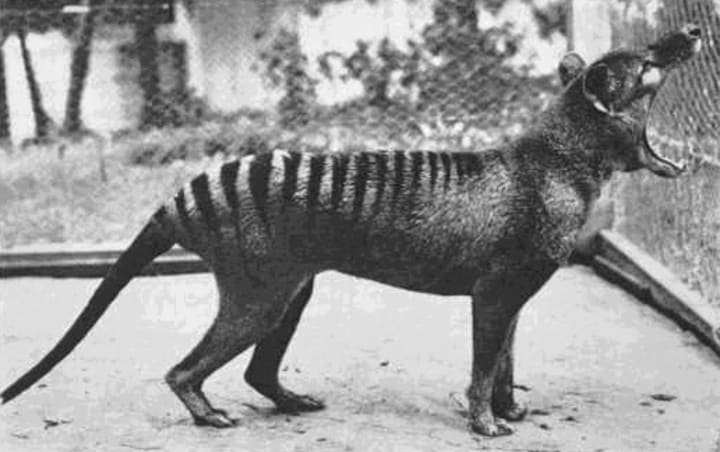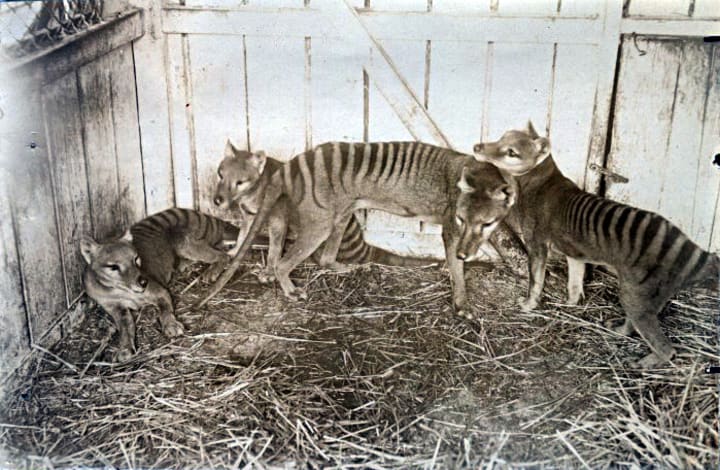Vicious Beast to Victim: Folklore of the Tasmanian Tiger
The Tasmanian Tiger lives forever (or so the legends are telling)

The Tasmanian Tiger or Thylacine is an iconic Tasmanian animal that went extinct in 1936 when the last Tiger died in captivity. Today, the animal is steeped in myths and legends that have been weaved into its history since the nineteenth century. The Thylacine experienced varying treatment by groups that each had different values and dealings with it. This includes the contributions of a struggling scientific front in trying to understand the unfamiliar, farmers with inept farming practices and naturalists in support of the animal. Not many people are aware of why the Tiger is embraced as a state icon in Tasmania, Australia, and how the media and public perception evolved over centuries to end with a population with deep-seeded guilt and responsibility for the decimation of a species.
The struggling scientific front
Interaction with the Tasmanian Tiger possibly dates back to 1642 when Abel Tasman sighted the island, but it was not until 1805 that the first scientific description by Lieutenant-Governor Paterson was published in the Sydney Gazette and New South Wales Advertiser. In this piece the Tasmanian Tiger is described as
"truly singular and nouvel . . . certainly the only powerful and terrific of the carnivorous and voracious tribe yet discovered on any part of New Holland or its adjacent islands. It is very evident this animal is destructive . . . the form of the animal is that of the hyoena, at the same time strongly reminding the observer of the appearance of a low wolf. The lips do not appear to conceal the tusks."
At this early stage the Thylacine was plagued with "ominous signifiers that activated fears traditionally associated with European species such as the hyena and wolf." From its first introduction to Western settlers, the Thylacine’s reputation was tarnished by allusions to its resemblance to Western predators of hyenas and wolves, carnivorous and canine in nature. This first-impression would directly influence public perception of the animal.
Defensive farmers
Newspaper articles in the nineteenth century frequently reported on incidences of men and/or their dogs killing Tigers, and Tigers in relation to sheep predation. An article by a correspondent in the Colonial Times in 1836 states how to bait, trap and kill "the great enemies of the flocks of this Colony" by public request. The "ravages of the vermin" are central to this piece as that is the said reason why the author is giving direction on how to deal with the pests.
Robert Paddle notes in his work that in the early 1800's there was never any mention of the Thylacine posing problems to farmers in the official annual reports on the sheep industry. It seems that the reports of Thylacines attacking and killing livestock were greatly exaggerated, whether it was due to a fear of the unknown hyena and wolf-like creature or to cover farming mismanagement, as "few reports of attacks involved actual sightings of thylacines and even fewer were able to furnish evidence of their presence." A letter to the editor in The Tasmanian News in 1887 supports the argument that Thylacines were not as notorious for sheep predation as we are lead to believe as a farmer writes
"there are comparatively few sheepowners troubled with those vermin . . . it would be a great injustice to the whole country in paying for the benefit of a few wealthy sheepowners. The farmers could more reasonably ask for help to destroy the parrots, which are on the whole much more destructive."
However, the editor responded that large areas of land are infested with Tigers.
Man versus Beast
Newspaper articles in the nineteenth century often used negative language to describe the Thylacine, frequently alluding to them as pests, vermin, enemies, savage and vicious brutes. An article titled "Encounter with a Tasmanian Tiger" in the Illustrated Sydney News in 1867 details "a hunt of the most exciting kind" between a tiger and man. The author notes that the Tasmanian Tiger is "by nature a coward" that can be ferocious but "human strength and contrivance were against the brute" which was beaten to death by the man. It is also extremely common for articles when taking an informative tone to label the Thylacine as a coward yet a ferocious savage when forced to be.
The First Peoples of Australia had a more appreciative view of the Tiger. David Owen sheds light on one of the few Indigenous stories still existing today called 'Corinna, the Brave One' in which a Thylacine pup is placed as the "bravest of the brave . . . the Great Ghost Tiger" who earns his stripes with his courageousness. This differs greatly to the original European perceptions of the Tiger particularly by early settlers and farmers who likened it to the devilish hyena and dangerous wolf, considering it vermin and a vicious adversary. Interestingly, as the tiger became rare and concern grew for the species, the perception shifted to create a hybrid of the Indigenous and original settler attitudes to see the Thylacine as a "noble savage."
The Bounty: decimation imminent
In 1888 pastoralists lobbied the Tasmanian Government to introduce a bounty system for Thylacines for one pound per adult and ten shillings for a juvenile, which added to other bounty systems such as that introduced by the Van Diemen's Land Company in 1830 ending in 1914 and also money earned by giving pelts to tanneries. In the twenty-one years the Government bounty system functioned it paid over 2,000 bounties, yet other sources take into consideration skins delivered to tanneries and state that at least 4800 Thylacines were killed between 1878 and 1909.
Other factors such as introduced competitive species, human destruction of the environment, and disease also led to the Tiger's extinction and literature varies in placing this extinction event as a natural process due to the species 'inferiority', or a direct result of human interference. In this case, the extinction of the Tiger called into question the notions of responsibility and agency. With humans placed with the responsibility of its extinction, "the thylacine, in its ideal form, is cast as unable to adapt to change, a victim of evolution and marsupial inferiority/innocence, helpless in the face of progress."
Perceptions shift as endangered becomes extinct
The 1920's held a theme in public media of the Tiger's vulnerability and quickly decreasing numbers began to alarm people who recognised the creature's value too late. An obvious change in popular perceptions of the Thylacine can be observed in newspaper articles in the early twentieth century that often held an informative stance in writing about the Tiger's appearance, biology and behaviour, and also brought the animal out of alienation as it was emphasised for being unique and native; belonging.

An article about the Tasmanian Tiger in The Age in 1937 describes the animal's characteristics and the hopes of confirming its continued existence in order to designate a sanctuary for it. The author introduces it as a quaint animal that Tasmanians always held an irrational superstitious dread for. In 1938 in The Adelaide Chronicle an article by Edward Samuel also aims to educate the readers on the nature of the Thylacine whilst reporting on the expedition to find the last Tigers. The author describes how they were victims of organised hunts and were forced to retreat into the most inhospitable regions of Tasmania, safe from human threats, "where it is believed to be making its last stand." These articles are only two examples of the many that focused on human agency in the Thylacine's demise, the animal's victimhood, and the latter also provides an early example of the belief or hope that the species remains safe from human interference deep in the Tasmanian wilderness, a hope that persists to this day.

The Thylacine lives on
The human involvement in the Thylacine's destruction or persecution is a central contributing driver behind the folklore of the Tiger's continued existence and the many sightings over the decades. The strong sense of responsibility, guilt and regret are clearly felt by people in the early 1900's. David Fleay, a passionate naturalist, recollects with "bitter disappointment" his failed expedition to find and save the species in an article in The Courier-Mail in 1953. Fleay highlights the animal's uniqueness, the superstitious dread of the colonists, and the hope it survives "away down in the cold inhospitable wilds of south-western Tasmania." He chooses to introduce his article with a powerful sense of regret that "it is to our lasting shame that so vastly an interesting creature . . . should have been allowed to slip away." Such feelings were particularly evident in articles written by naturalists, but were felt by the public and remained with the human population for decades.
In 1987 in a Tasmanian Parliament session on what animal to use for the flag Bob Brown argued for the Tasmanian Tiger for "it was not dead in the hearts and minds of blueblooded Tasmanians" who "shouldn't forget what they did to it." This responsibility and guilt is carried into the new century as in 1999 Dr Mike Archer declared that cloning the Tasmanian Tiger would "reverse one of the great blots on the history of the colonisation of Australia . . . there's a moral imperative here. It's not God's will that the Thylacine went extinct. We did it." The use of the word 'we' suggests that the generations of people following those that actively hunted the Thylacine or stood as bystanders carry the blame of their forefathers.
Nicholas Smith's work explores the idea of the Thylacine being the 'undead' which goes in hand with the strong sense of blame and guilt. Metaphorically, this means the Tiger has not been buried properly and therefore has returned from the dead. Using the theory of the undead, Smith suggests that "until the trauma of colonial abjection is reconciled . . . the undead will continue to return and haunt the Australian imaginary."
The living dead or undead theory adequately gives an explanation for the hundreds of sightings of Thylacines both on the mainland and in Tasmania. Another aspect to consider is how the treatment and perception of the Thylacine today is heavily influenced by its use in Tasmanian tourism. The Tiger is an integral part of Tasmania's identity, often used in tourism "in a language of loss, implying an ongoing quest, suggesting that the missing marsupial . . . may still exist." The Tasmanian Tiger can be seen in many shops in Tasmania in the form of keyrings or plush toys and other items but it is also used in the logo for Tasmania accompanied by the catchphrase "Tasmania: Explore the Possibilities." Rumours of the animal's existence which is now close to the heart of Tasmania may influence the number of sightings in the state, with tourists or locals seeing what they want to see or have heard and seen so much of in Tasmanian culture. The mysteriousness of the landscape, and also in the nocturnal and elusive nature of the Thylacine led many to believe that the animal still exists.
From 1936 until today, over 1000 people have claimed to see the Tiger on mainland Australia alone. Post-extinction sightings of the Thylacine in Tasmania or mainland Australia and began a frenzy with media all Australian states reporting any news regarding the possibility of the Tiger's existence through sightings or the many expeditions taken by individuals or official groups such as The Animal and Birds Protection Board. David Fleay's expedition in 1945 is one example that received attention from several newspapers. During the mid-twentieth century another trend in newspaper articles was the tendency for the language to infer the Tiger was alive, with writers labelling the species as rare. For instance, after tracks were found in 1953 an article in a New South Wales paper Barrier Miner labelled the Thylacine "one of the world's most rare mammals." In 1957 The Argus also held an article that quickly latched on to the idea of the animal's survival, hailing the good news of a promising sighting from a helicopter. Although overwhelmingly positive with an air of excitement, the article ends with a solemn reminder of the actions of the settlers, warning that "above all, do not let it be exploited to its own destruction."
Life in death … a summary
Before the extinction of the Tasmanian Tiger newspaper articles held themes of human-Thylacine confrontations with an exciting hunt or chase resulting in the animal escaping or killed by man. Negative language or inferences were also common through calling the Tiger inferior, vermin, pest, ferocious, stupid, brutes and savages, a significant contrast to Tasmanian Aboriginal perceptions. This negative perception of the Thylacine was promoted by the animosity of the colonists, particularly inefficient farmers in an alien landscape, and its treatment by the early scientific front which unfortunately likened it to other predatory species which activated traditional European fears. The promotion of the idea that the Tiger was bloodthirsty vermin led to its demise through excessive hunting to collect bounties. Its growing rarity caused a shift in popular perception of the Tiger which emphasised the animal's uniqueness, nativeness, and victimhood followed by a desperation evident in newspaper articles post-extinction to find evidence of its survival with a media frenzy on sightings and expeditions. The regret and guilt plainly felt by people particularly in the twentieth century is strongly linked to the theory of the Thylacine being the undead and unreconciled colonial trauma, which can explain the reported sightings. The strong presence and treatment of the Tiger in tourism may also be a contributing factor to supposed sightings and the hope that it still survives in the wild. Each of these perceptions and treatments of the Tasmanian Tiger that have developed over time experienced a crucial shift after the extinction event and work together to create the folklore behind the Tasmanian Tiger's continued existence.
________________
Thank you for reading, your attention is much appreciated. If you enjoyed this piece, leave a heart!
For your next slice of history, you might also like to read this:
About the Creator
Eloise Robertson
I pull my ideas randomly out of thin air and they materialise on a page. Some may call me a magician.
Enjoyed the story? Support the Creator.
Subscribe for free to receive all their stories in your feed. You could also pledge your support or give them a one-off tip, letting them know you appreciate their work.







Comments
There are no comments for this story
Be the first to respond and start the conversation.